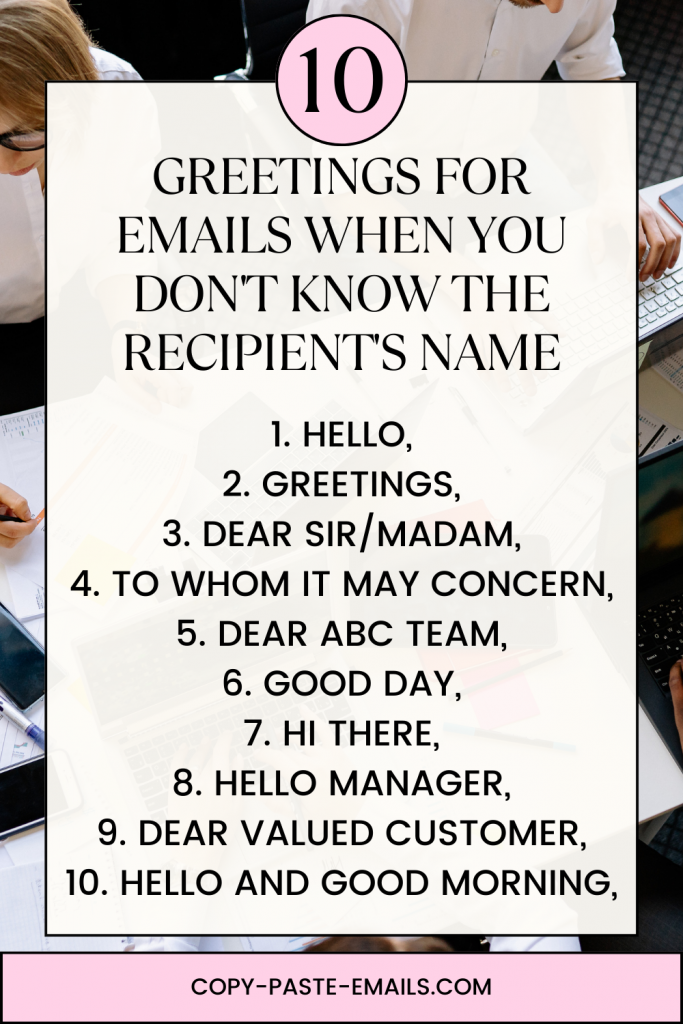When we write an email for the first time to someone, very often we have some standard email starting with “support”, “office” etc. In these cases it isn’t easy to know if we are writing to a man or a woman, not to mention that we don’t know their first or last name. In such cases, we put a generic greeting that will be appropriate for each person. In this post, we will show you the best greetings without name to use in your email.
Why use nameless greetings in emails?
You don’t have to start every email with a personal message. Sometimes we need to use a more generic greeting when we don’t know the recipient’s name or we are addressing a larger audience. Such emails sound more formal and can be used in a variety of contexts. Even sometimes it is better to use them when you are not sure if the recipient is a man or a woman or you do not know if this email is for the HR department or the sales department. Using an email without a name in the subject line will prevent any awkward situations.
Additionally, if you are sending email to a lot of participants or automated email templates, general greetings is not only advisable but imperative to use.
10 Greetings in Email Without Name
1. Hello,
We put first Hello because it is a friendly, neutral greeting that works for a lot of situations. It’s direct but not too casual or formal.
Example:
“Hello,
I was looking at different companies on the internet and came across yours. I see you have a good portfolio and would be happy if we could make an appointment to discuss a potential future partnership between us.”
2. Greetings,
Greetings is a bit more formal – it can come across as respectful, so it’s good for business emails to people you don’t know.
Example
“Greetings,
I am writing you this email because I saw online that you offer English courses. I am interested and would like you to give me more information.”
3. Dear Sir/Madam,
Dear Sir/Madam is a traditional, formal greeting to use when you don’t know the gender of who you’re writing to. People often use it in formal business letters and emails.
Example
“Dear Sir/Madam,
I am writing to submit my application for the position advertised on your company’s careers page.”
4. To whom it may concern,
to whom it may concern is very formal – you’d use it in official letters when you don’t know the specific person who will get the letter. It’s a catch-all phrase to make sure the right person gets it.
Example
“To whom it may concern,
I am trying to find out who I can contact about an issue related to a product of yours that I recently ordered from your website.”
5. Dear (Company Name) Team,
Dear (Company Name) Team is good when you’re emailing a whole team or you’re not sure who at the company will read it. It’s inclusive.
Example
“Dear ABC Team,
We are pleased to invite you to our upcoming webinar where we will introduce you to the new partner program, a global leader in cybersecurity solutions.”
6. Good day,
Good day is polite and slightly formal. It’s neutral and can work in a lot of professional settings.
Example
“Good day,
A colleague referred me to your services. Could you let me know when you are available so we can discuss possible consultation dates?”
7. Hi there,
Hi there is less formal than hello but still neutral. It’s friendly and fine for more relaxed situations.
Example
“Hi there,
I noticed a problem with my last order. Can you help me with the return?”
8. Hello (Job Title, e.g., “Hello Manager”),
Hello (Job Title) can show you took care to direct your message properly if you know their role but not their name.
Example
“Hello Manager,
When you have a chance, could you give me 30 minutes to tell you about an idea I have about optimizing some processes in the company?”
9. Dear valued customer,
Often used in customer service or sales where the customer’s personal details may not be known. It expresses appreciation and respect for the recipient as a customer.
Example
“Dear valued customer,
We would like to present to you our latest promotion of ABC products. Take your chance now and order them at a special price of only 15 USD.”
10. Hello and good (time of day, e.g., “morning” or “afternoon”),
Adds personalization based on the time the email was sent. It confirms the present time and can set a friendly email tone.
Example
“Hello and good afternoon,
I hope this email finds you well. I wanted to discuss the agenda for our upcoming meeting.”

Which are the most formal greetings without a name?
Among the 10 greetings previously mentioned, “Dear Sir/Madam”, “To whom it may concern” and “Dear (company name) team” stand out as particularly formal and traditionally used in a professional context. These greetings convey a high degree of respect and formality. They are particularly preferred in communications where the sender wishes to maintain a neutral tone, such as formal inquiries, or applications, or when addressing an entire organization or department where individual names may not be known.
Closing
You’ll never go wrong if you just use “Hello” as a greeting when you don’t know the recipient’s name. This is the most standard and most used greeting. But if you want to sound more professional and respectful you can use the greeting “Dear Sir/Madam”. If you have no idea to whom the email is addressed, you can use “To whom it may concern”.









